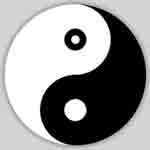This book explores the Micro-World of subatomic
particles and forces, including the recently discovered Higgs boson.
The pursuit of nature’s smallest parts is one of mankind’s oldest
quests, beginning at least 26 centuries ago. But, just in our lifetimes
it seems we’ve finally “hit bottom.” Each step deeper into the
Micro-World has revealed surprises, and expanded our understanding of
nature on all size scales. At the bottom, we see a remarkable unity —
nature is the same everywhere. Each galaxy could have been made of
different types of matter, just as Earth’s continents have different
flora and fauna. Instead, everything everywhere in the universe is made
of just the same few elementary parts.
Einstein said: “The most incomprehensible thing about the universe is
that it is comprehensible.” Now we know why. It is the simplicity of
its smallest parts that allows us to comprehend the bewildering
diversity and scope of our universe.
Example

|
In
nature, there seems to be a yin for every yang. For each type of
particle of matter there is a corresponding type of antiparticle of
antimatter. Antiparticles have the same mass as their particle
partners, but all their other characteristics are opposite. For
example, the antielectron has the same mass as an electron, but its
electric charge is +1 instead of –1.
|
|
|